In February 1948, the Melbourne Public Library opened its doors to the first 35 students of its new training school for librarians. There was no shortage of eager applicants. Between sixty and ninety candidates applied each year, but only 35 prospective students would make the grade.
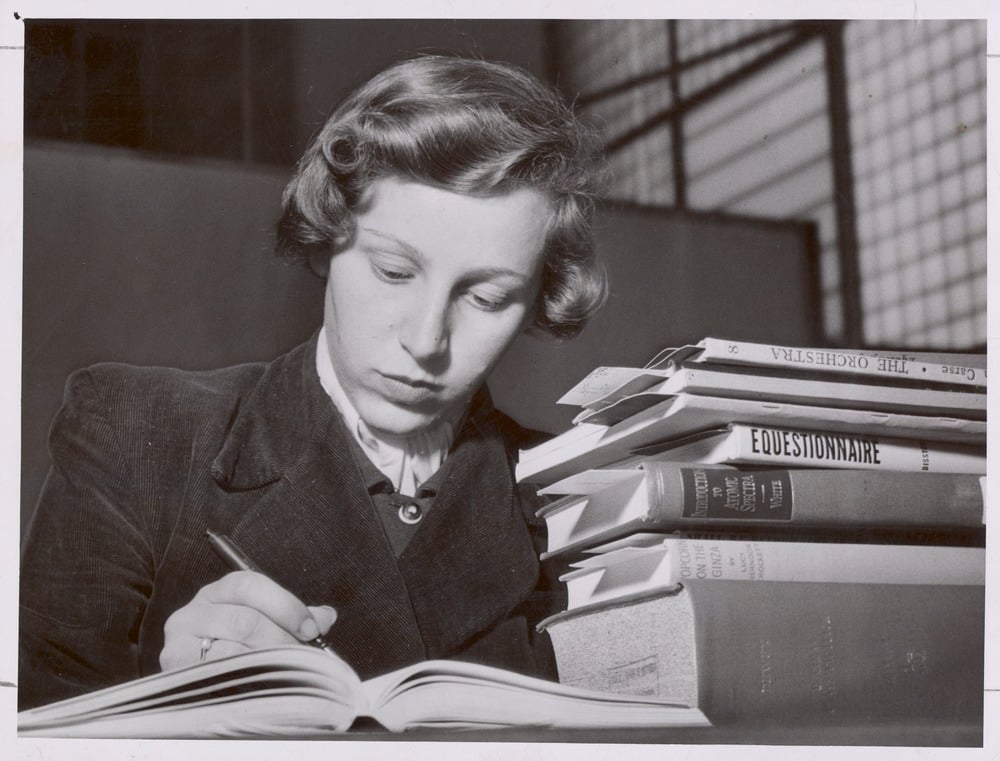
[Library workers in Australia]. This work is in copyright; H2002.199/648
Subjects studied by students included: history of the book, cataloguing, classification, indexing, book stock and its maintenance, history of the library, and reference work. You can read a sample assignment from the Library Training School here.
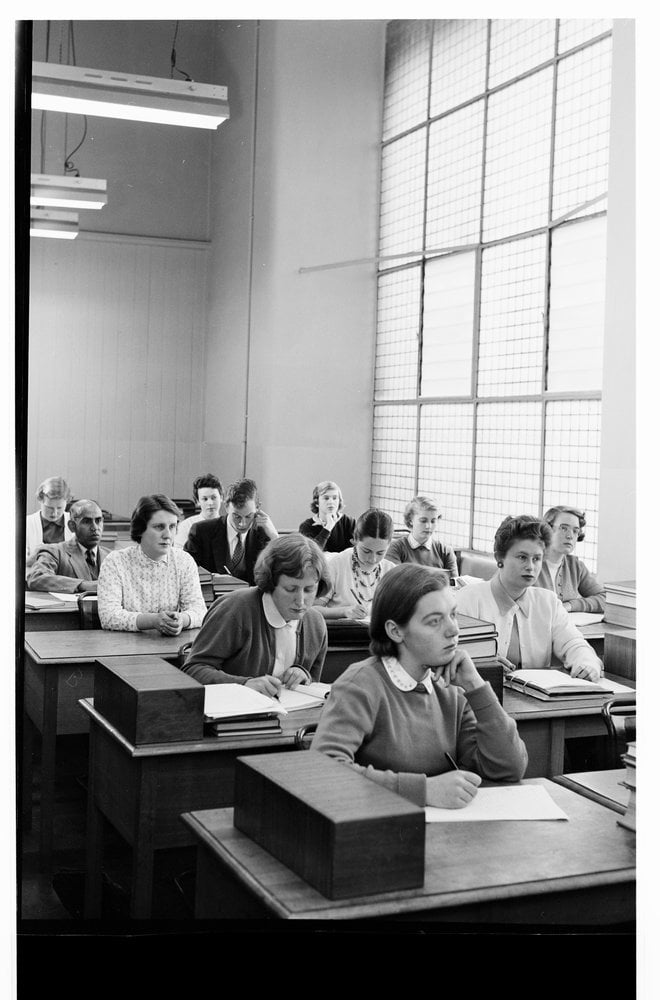
[Library school of the Public Library of Victoria]. Photograph by Mark Strizic.
This work is in copyright; H2008.11/268
According to The Argus in 1953: ‘Personality, a wide range of interests, patience, ability to get on with people, and physical fitness’ were some of the qualities scoring high in the selection criteria for prospective librarians.

[Public Library of Victoria – staff and public]. Photograph by Mark Strizic.
This work is in copyright; H2008.11/284
The Library Training School pulled no punches in its own assessment of what was required to make the grade as a librarian.
‘What is the essential quality for a librarian … ?’
lecturer J.A. Feely asked his students in 1948.
‘Undoubtedly it is that indefinable quality known as “nous”. “Nous” is a useful quality in most fields, but it is particularly so in this one. A good general background is necessary – he must be all things to all men – and women – and children. A really ignorant junior librarian in a library is a nuisance. An ignorant librarian in an Inquiry Room is nothing short of a catastrophe’. [1]
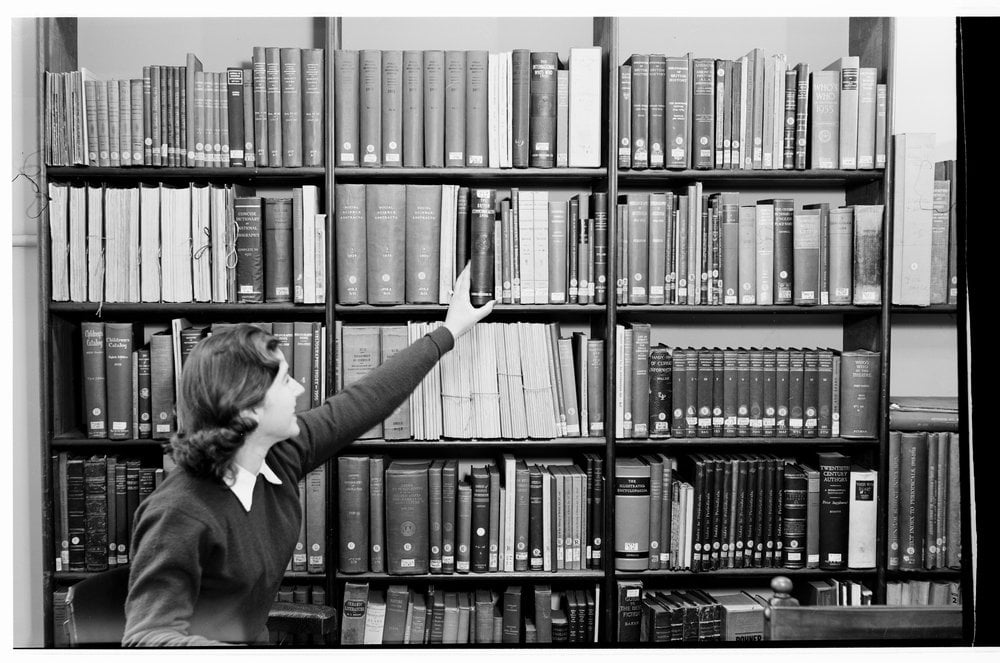
[Public Library of Victoria – staff and public]. Photograph by Mark Strizic. This work is in copyright; H2008.11/276
If candidates were under any lingering doubt as to how to know when they’d made the grade as a librarian, Feely offered this sage advice:
‘’When you can get to the point of registering no surprise at a question such as … “How long does it take to have a baby elephant?”, you are well on your way to acquiring the things which are beyond the technicalities of the profession’. [2]
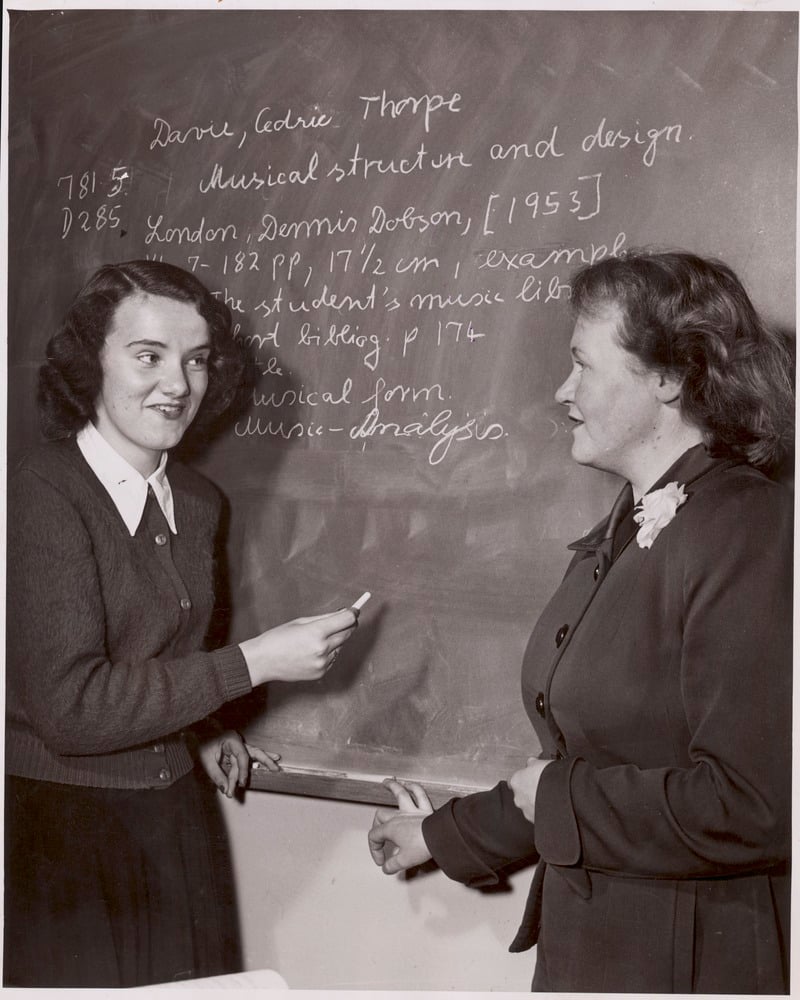
[Library workers in Australia]. This work is in copyright; H2002.199/649
Gender disparity proved a headache. The Age lamented in 1950 that ‘library work is rapidly becoming a women’s profession’. Trustee of the Library Board Mr A.E. McMicken agreed, telling The Age he knew of only two male librarians in all of Melbourne.
Loss of personnel was also a problem, as the marriage rate of librarians was purportedly high [3].
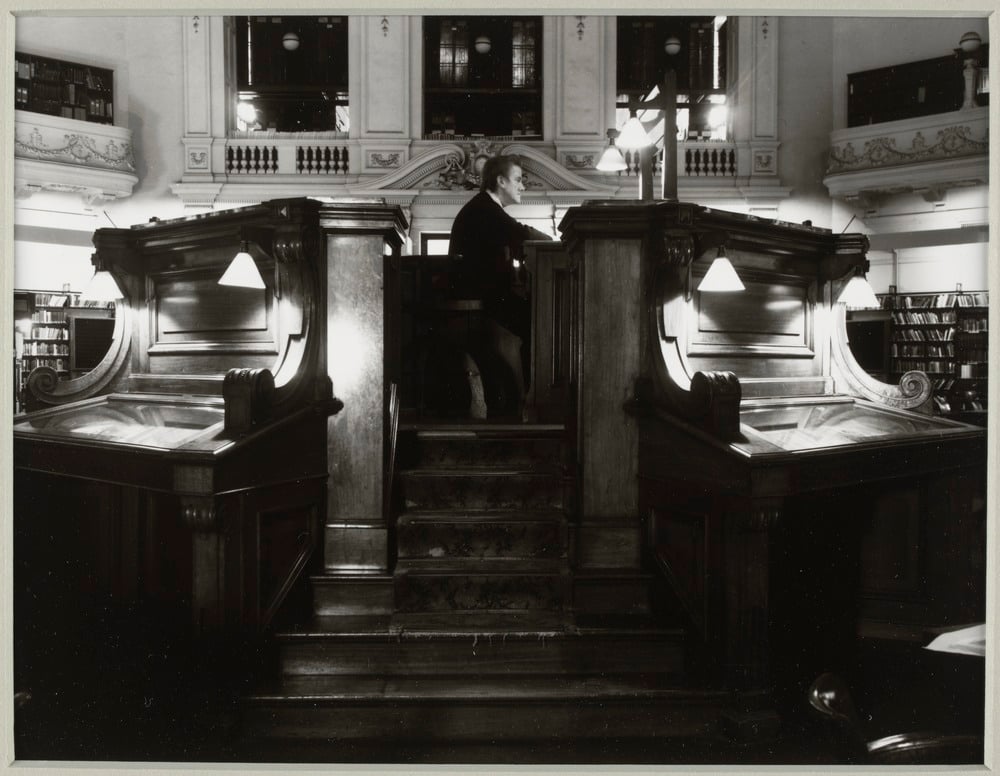
[Central dais, the Domed Reading Room, State Library of Victoria]. Photograph by Viva Gibb; H88.55/6
In 1950, The Age newspaper painted a picture of a typical graduate. Philippa Neill, the first Library School alumni to be appointed readers’ adviser at the Melbourne Public Lending Library, was ‘[b]rown-haired, brown-eyed with an easy smile’. She was ‘approachable, and attentive, and only too ready to discuss any subject with prospective readers’. Philippa considered herself to be more of a readers’ friend than a readers’ advisor and described being a librarian as ‘a lovely job’ where there was ‘always something new and different to do’.

[Female staff member using roneo machine]. Photograph by Mark Strizic.
This work is in copyright; H2008.11/323
All in all, more than 300 students passed through the halls of the Library Training School before it closed its doors to new students in 1969.
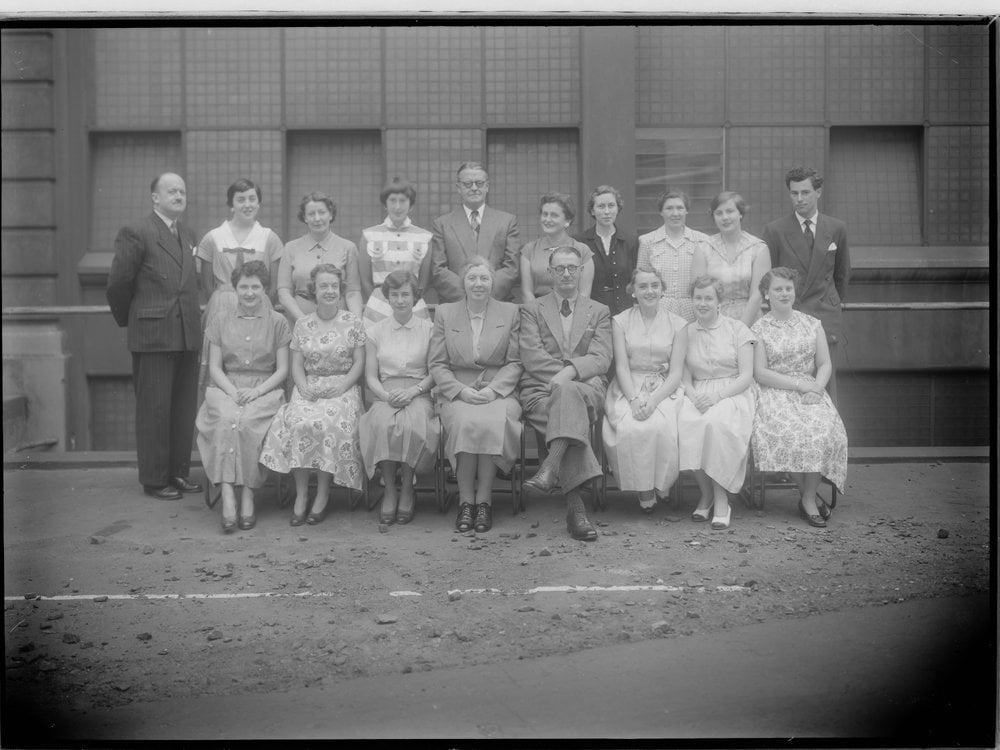
Class of 1954. Group portrait taken outside Dome building; H36744
But perhaps the last word should belong to lecturer J.A. Feely:
“This business of being a librarian worthy of the calling is not an easy one. In these days when it is fashionable to sneer at an ideal, the words of the great Carnegie are in imminent danger of being forgotten: ‘Consecrate yourself to your profession for it is noble.’ ” [4]
References
[1] Feely, J.A. Lecture notes 1948 Melbourne: The Library p. 40
[2] Ibid, p. 42
[3] McCallum, C.A. The Public Library of Victoria, 1856-1956 Melbourne : The Library
[4] Feely op. cit. p. 43.


Very interesting reading Sarah!
Thanks Hellena!
It sounds like you had a ball researching and writing this post Sarah! Great work.
It’s important to remember why we do the things we do so thank-you.
Mr Feely certainly left an impression!
Thanks Terri. I’m glad you enjoyed reading it as much as I enjoyed writing it.
Nice work Sarah, fortunately we have moved on and I note in the photo, not one set of pearls or a twin-set to be seen! Brilliant! Good to know that librarians generally ‘like’ people and offering assistance to lots of different questions. Long may that continue. If we lose our curiosity, we might as well give up. Cheers R
Interesting Article…Thanks for the writers
Love this. Nothing has changed – librarians and officers must still be all things to all people and be warm, enthusiastic and interesting. No challenge if you love your job.
I was in the class of 1965 and sat on the other side of the lecture room shown in the photos. The head was Miss (Ursua) O’Connor with Miss (Joan) McMicken, daughter of A.E. Mc Micken. Specialist lecturers were Mrs (Margaret) Ingham – children’s literature and Barrett Reid – cataluguing. Mornings in the lecture room, afternoons in various departments under STRICT supervision. I was one of the lucky twelve with a scholarship which was £7 a week less tax 5/-. As my board at the Priness Mary Club around the corner in Lonsdale St was £5 there was little to spare. It was paid in cash from a window off the old newspaper room. Those were the days! On day one We were given a copy of Dewey (16 I think), ALA filing rules to learn by heart and a 3 inch tome The Book by McMurtrie to absorb. All the above librarians have died and I am retired and 70 after a long and happy career at Corangamite Regional Library in Colac with 10 libraries and 2 mobiles covering southern western Victoria. Marvellous memories of a great career. What a pity the photos do not have name labels.
Thanks…I could go,on and on!
Wonderful to hear from an original student Marjorie. I enjoyed reading your post. I’m writing this from the newspaper room at the State Library – I love this place, we’re very lucky to have such a wonderful library in the city. Good luck to you.
wow!! Thank you for sharing your history. So special.
Fabulous information, with some real names, thank you Marjorie. Please do go on! I for one would love to read more – too little is on the record about the significant role of women in book history.
Do you happen to know the woman in the photo H2008.11/276? It looks very like my mother Helen Newman who would have done the course in about 1953 I think.
Hi David, I have checked the catalogue entry but unfortunately the staff member is not identified. The Pictures team have confirmed that if a name had been available would have included it in the entry. Sarah.
I was lucky enough to be accepted in 1965 and studied full-time for one year at the Library School. I remember one of our lecturers was Barrett Reid, he was very inspiring. It was the start of a life-long love of the State Library and a career as a public librarian.
Gail White (nee Williams)
I wld have loved to be a librarian but the opportunity never arose. Librarians must have University qualifications as opposed to being an intelligent person who loves books, has excellent spelling, grammar and an inquisitive, eclectic nature where all information is a joy to acquire – and great for Trivia nights!
The insistence to hold University qualifications cuts out many excellent candidates for the role of Librarian.
What a waste of resources.
Librarians did not require university degrees for many years. The Library Association conducted exams well into the 1970s for qualification as a librarian. In NSW the TAFE course gave library qualifications until the Library Technician qualification was created. In the 1980s, at least 1 NSW university would not accept a 3 year library degree as a qualification for a librarian, but did accept the registration papers.
A degree was required in the State Public Service in NSW for progression to Senior Librarian levels, but this was removed in the mid 1980s, so that senior librarians with no degrees were found in TAFE and the State Library
Thought # 2
Good librarians should check the catalogue record before making comments – some of the photos do have names. The class of 1954 has several people I remember – I feel sure the one labelled W. o’Connor is the previously referred to Miss O’Connor, M. Anthony is Margaret (Peg) who was SLV Collection Development now in active retirement at Birregurra and involved in local history, Lee Ellis was librarian at Sandringham and Ruth Kirsner later Cameron was at Camberwell.
J Cornell (back row, third from left), better known as Jane La Scala, ultimately became State Librarian in a career that took her to Canada as well as Coburg City Library and Public Libraries Division of the LCV. Sadly she died this year.
Sorry, fourth from left.
Hi Marjorie,
I can confirm that it is the lovely Peg Anthony in the 1954 class photo, back row 7th in (as I recognise her as a neighbour from Birregurra).
I also have the unfortunate role of giving the news that Peg passed away yesterday 26/09/2017.
My mum and aunty both worked at the State Library in the 1940’s or 50’s. I wonder if there is a photo of them in your collection.
Hi Helen, It’s possible. Try a catalogue search using their surname (sometimes first names were not included in the catalogue entries). We also have a great research guide about the State Library’s history. You can find it here. Sarah.
Thank you, Sarah. I enjoyed your account of an era well past. I wholeheartedly agree with much of Feely’s required characteristics yet in today’s world it is simply not enough. The technical requirements of new and emerging technologies continue to challenge, frustrate and , hopefully, stimulate our profession to rise to their challenges while retaining the natural curiosity and commitment to learning and discovery by ourselves and others.
Thanks for a interesting article Sarah. The pictures really brought the story to life. I found this via an ALIA newsletter
Hi Sarah,
I can help you with naming one of the persons showned in one of the photos.
It is of the man sitting in the Dias in the Domed Reading Room.
The Person’s name is Victor ( Vic) Fleming. He was not a Librarian, he was an attendant, Nowadays called a collection access officer. I showed the photo to Kent who confirmed it was Vic. When I started at the Library on a project in October 1983, and got an attendant’s job in July 84 in the main Reference library, Vic was one of my supervisors. He had an unusual handwriting style.
Vic started at the State Library in 1971 and finished in June 1993 when he took a redundancy package. Vic’s previous job was as an Usher at the Cinemas.
Unfortunately Vic died in the early years of the 2000’s.
Great Blog Sarah.
Great. Thanks Marino. It’s wonderful to hear everybody’s stories. You can find more stories in response to the blog post on SLV’s Facebook page too. Sarah.
Lovely post – THANK-YOU!!! A couple of those exam questions reminded me of one of mine in QUT’s library & info science grad dip program (library services course) 20 years ago. Sandra
Terrific blog Sarah, great photos! I’m sure Mr Feely
would be proud of you!
Thanks Roger!
Sarah,
I love the pics you put on line.
Fabulous!!
Lynda
Thanks Lynda, I’m glad you enjoyed it. They were fun to find! Sarah.
great pictures you got there
Love the images you’ve used in this Sarah. The women all look so well-groomed and astute.
Great blog and great photos Sarah, I will be printing this out and keeping it with my other things. I collect anything to do with the State Library, shame the SLV news is not produced anymore – I collect those too. Well done anyway, Don.
I was a library student at the State Library in the early sixties, the only tutor whose name I recall was Jean Hagger. There was no degree course at that time in Melbourne, and the subjects on offer then were very different to the BSSc degree now….as they should be!
Great reading. Love the photos. The people skills still are so important. Thanks.
I’m delighted to read your blog Sarah and the comments, thank you. The picture of the lecture room looks exactly as I remember it. I’m happy to know that people are interested in this small piece of Victorian library history.
Both my husband Paul Bywater and I were library students at the Library School. Paul started in 1961and I started in 1962. At that time we both worked at Box Hill City Library (later Box Hill- Doncaster Regional Library). We attended classes in the mornings and worked at Box Hill Library in the afternoon, plus 2 evenings a week and on Saturday morning. The lecturers I remember were Ursula O’Connor, Joan McMicken, Beatrice Mattei, and Barrett Reid and the occasional visiting lecturer. The head of the school was Frank Perry, a delightful older Librarian who as well as being on the staff of State Library, had been active in developing Libraries in Indonesia.
I think we were very privileged to learn our craft from such experienced librarians, and to have the amazing resources of the State Library all around us. Ursula O’Connor allowed the class to examine many of the treasures from the library’s Manuscript and Rare Books collection. She shared the early history of the Library, including the role of Sir Redmond Barry. One of our classmates was Maisie Purves Smith who was Children’s Librarian at Camberwell Library. Maisie later married Russell Drysdale.
In September 1963, Paul was appointed as Regional Librarian for East Gippsland Regional Library based in Bairnsdale. We were married in March 1964, and lived in Bairnsdale until mid 1967, when we moved to Hobart Tasmania. We both worked in various sections of the State Library of Tasmania in the 1970s and 1980s. Paul retired some years ago. Since 1992, I have had an amazing time, working in Cambodia as a Libraries adviser, building collections, training librarians, students and researchers at the Royal University of Phnom Penh. I am not ready to retire while I am still enjoying the work and the people here.
Margaret Bywater
Libraries adviser.
Royal University of Phnom Penh, Cambodia
Margaret,
I am so glad you saw this post. I was going to bring it to your attention.
Great post. I love the photos.
Thank you
Gulcin
Gulcin Cribb
University Librarian
Singapore Management University
Great blog post for anyone interested in the history of librarianship. I am currently researching the history of the librarianship/information management program at RMIT which commenced in 1964 when the State Library ceased night classes. Eventually RMIT took over completely from the SLV with the first undergraduate librarianship degree in Australia. RMIT and the SLV continue to work together in a variety of activities and projects. Miss Hagger was the first female head of school at RMIT from its founding in 1887 to 1964.
I also was one of the 1960s students and a foundation student of the course at RMIT. I did my last subject by correspondence when I moved to Tasmania to be the first Regional Children’s Librarian for the Hellyer Regional Libraries in 1966. I commenced while working at Malvern [later Malvern-Caulfield] when we were given time off to attend classes at SLV, RMIT classes were evening so I went after work
Valerie – If you see this I would love to interview you for the history of librarianship at RMIT that I am writing. You can find me by searching the RMIT website.
My brother-in-law, Gordon Kirby was one the educators who moved from the SLV to RMIT. I am not sure how long he was with the library school at the SLV. He worked with Jean Hagger at RMIT and it is a pity that he met an untimely death as he was a great one for writing histories and I know he had kept a lot of documents and photos.
Gordon taught me first year cataloguing at RMIT and was a great lecturer. I remember many of us being just a little bit terrified of him at first, as he so opinionated. But we soon discovered what a funny and interesting man he was.
Bev – Indeed a great pity. I have seen his name in my research
Great article with some lovely photographs Sarah!!
Amazing to think how things have changed over the years, but the principles remain the same
Love someone to do the same for WA. I was in the late 60’s era but have forgotten the names of our lecturers – mostly State Library staff. I did my last few exams by private study with fellow students from the City of the Blue Mountains libraries, sitting the exams at Sydney Uni. Moved back to WA to become City Librarian for City of Gosnells for 20 years seeing many changes in WA libraries in that time. Ended up marrying the Raeco Library Supplies rep. For WA, Roger Stanton – known to everyone at the time as Roger Raeco!!
To add to your great story- Thank you – – I was fortunate to be a member of the first Geelong LAA class, conducted by Mr C P Billot , the new Chief librarian from England, from 1965. I remember we were taken to the State Library for occasional lectures which included Mr.Barrett Reid; Mrs. Margaret Ingham, and Miss Jean Hagger. Mr. Billot enthused us in local history (and he wrote his own histories of Geelong).. The LAA exams were sent by mail from Sydney, and we had to wait each year from December till February for posted results! We all had to have 3 years paid library work and had to wait till 21 to receive the LAA Registration certificate. This has enabled us to be librarians in public, school, National, Gordon and Deakin libraries.
A story – – In class we were asked to study the American Munn-Pitt report from 1937 on Australian libraries – The Geelong library was described as “A cemetery of old and forgotten books”-come and see it now a world class library. This growth in importance of Australian libraries must be one result of the education of librarians, and our continued love for the profession and the people we serve.
Tricia O’Keeffe Geelong.
Hi Tricia, C P Billot was the first Chief Librarian at Box Hill City Library in the early 1950s, when I remember being with my parents when we all joined the library on the first day it opened. Little did I know that I would work at the Library from 1961- to early 1964.
I also remember studying the Munn-Pitt report, and the phrase that stays in my memory is ” Anyone wishing to retain a favourable impression of the xxxxx Library should not make the mistake of entering this Library. ( Not SLV of course)
Interesting blog & comments. Very few of the physical spaces which are in the background of the images have remained the same – and probably relatively few individuals are still around who could identify them.
Like Marjorie Morkham, I was a scholarship student at the SL Training School, but two years ahead, starting in 1963. I also boarded at Princess Mary Club in Lonsdale St., which was so convenient. I remember Ursula O’Connor and Joan McMicken. Also our other lecturers, particularly Barrett Reid, then lecturing in 5. administration, who was so entertaining while imparting useful information. It sounds as if the scholarship pay had increased very slightly by Marjorie’s time. I’m pretty sure I remember collecting 6 pounds 13/6 from the little window in the newspaper room. In 1964 I went to City of Footscray Free Library where Ruth Andrews was librarian and continued library studies by night classes at RMIT. Later to Swan Hill High School Library. Margaret Banks nee Campbell.
Hi Sarah, great blog. Did you mean that female librarians at the State
Library were required to resign their jobs when they married, as per general Public Service rules at the time until at least the 1970s? Or that many chose to leave when they were married or had children?
Thanks Kaz. The full quote from p. 30 of The Public Library of Victoria, 1856-1956 reads: ‘By far the greatest proportion of students have been women – indeed, less than a dozen men have been trained for public library work. As librarianship has now so largely become a feminine occupation, the loss of personnel by marriage has become a serious factor in staffing, for the marriage rate of librarians is high.’ Unfortunately the book does not state the reasons for the exodus of married women from the profession, but section 37(b) of the Public Service Act 1946 (Vic) – still in force at the time – stated that: ‘No married woman shall continue in office or employment in the public service after her marriage’. Sarah